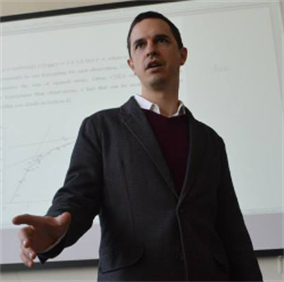Within the last 100 years, a shift in the United States economy has occurred. Previously, the workforce was comprised of predominantly farmers. Today, less than 3 percent of the workforce is in the agricultural sector. To accommodate this shift, manufacturing productivity must increase.
Dr. Andrew Johnson, associate professor in the Department of Industrial and Systems Engineering at Texas A&M University, is looking for ways to increase productivity in manufacturing and other historically important sectors to allow those needs to be met more efficiently.
“The huge productivity improvements in the agriculture sector allowed people to reallocate their efforts to other endeavors,” Johnson said. “All of those people who used to be farmers can now make music, study science, or cancer.”
Johnson began his research with a focus on the technical and mathematical issues related to estimating production functions to measure efficiency and productivity and found challenges in the data sets while testing the methods.
“For example, the U.S. Census Bureau, sends out a survey to facilities that do some form of manufacturing,” Johnson said. “This is to get a sense of just how manufacturing is growing or doing in the U.S.”
The Census Bureau conducts a Census every five years in which every manufacturing facility in America is surveyed. Then, in the four years in between, the bureau takes 15 percent samples of the manufacturing industry. While this is done randomly, bigger facilities are sampled more heavily.
“We are trying to help them understand if the survey of 15 percent is large enough,” Johnson said. “The first question is: if what you’re interested in is population characteristics for the census, is 15 percent enough to give an accurate characterization?”
The Census Bureau gathers the data from manufacturers, large and small, and requires a security clearance for academic institutions to use the data. This helps assure companies that the information collected will only be used in confidential research studies.
“It’s not only that you need a security clearance, but if you are going to access the data, you have to go to a Census Bureau Data Center to do the research,” Johnson said. “When you’re done doing your analysis, someone within the facility evaluates whether it is acceptable to let out for publication or let out for public consumption.”
About three or four years ago, the Census Bureau research data center was opened on West Campus at Texas A&M. Prior to that time, the closest data center was located in Chicago, Illinois.
“It has been my goal for four years or so to get a project through this security clearance process,” Johnson said. “Since the data centers are largely driven by economists and my research focuses have been a little bit different, it has been a challenge to match my proposals to their research needs.”
Johnson decided to begin his research in countries where similar data is also being collected to better understand what he could offer to the U.S. Census Bureau.
“Chile makes their information publicly available to the world and I have a joint appointment with a university in Japan that gave me access to Japan’s Census data,” Johnson said.
Johnson and his graduate students began using the data sets from Chile and Japan to prove their ideas and the questions they could answer for the U.S. with the data from the U.S. Data Center.
“By looking at the Japanese data and Chilean data, we’re answering the question in those data and indicating to the U.S. Census that we could provide similar insights for their data too,” Johnson said.
In addition to determining if a 15 percent sample is adequate, Johnson is also personally interested in determining if the productivity improvements drive competition or if they help current establishments’ survive.
“One of the hypothesis we are testing is the economics theory that says that when competition goes up, productivity should also increase,” Johnson said.
https://today.tamu.edu/2016/04/28/do-we-really-have-free-will/
Due to his work in Japan and Chile, Johnson attracted the interest of researchers in Colombia and Mexico.
“One collaborator is working at the central bank of Mexico and has access to these two data sets,” Johnson said. “So now, we’re starting some collaborative projects between my laboratory and her group.”
Johnson recently visited Yale University to present his results for Japan and Chilean. He and the director of the New Haven Census Bureau Data Center identified similarities in the data used in projects recently performed at the New Haven Data Center as potential for integration and collaboration opportunities in the future.
Johnson is currently going through the security clearance process and hopes to begin his project on Texas A&M’s campus in the Fall of 2017. Meanwhile, his laboratory continues to develop insights related to Japan and Chile. To follow his research, please visit his laboratory’s website at www.andyjohnson.guru.
This story was originally posted on engineering.tamu.edu.
Media contact: Aubrey Bloom, abloom@tamu.edu






